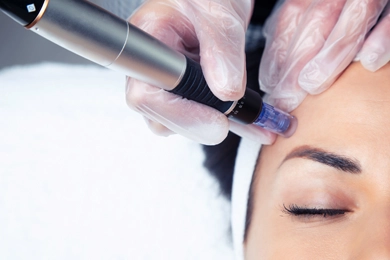
Collagen induction therapy, often known as microneedling, has gained popularity recently. The creation of at-home microneedling devices has been motivated by the growing demand for the procedure, which was previously only available in dermatological clinics and med spas. But is it possible to perform microneedling safely and effectively at home? And are there any possible negative effects of DIY methods? This comprehensive essay seeks to address these worries, offer information, and assist prospective patients in making decisions.
In order to perform microneedling, a tool is used that has small needles that puncture the epidermis of the skin. This regulated injury starts the body's natural healing process for wounds by encouraging the formation of collagen and elastin. The outcome? a more youthful appearance, decreased scarring, and improved skin texture.
The market for at-home kits expanded along with the popularity of microneedling. These do-it-yourself kits are intended to provide a more practical and reasonably priced treatment option. The needles on at-home devices are typically shorter than those on professional ones.
The following are the main variables influencing the popularity of at-home microneedling kits:
Cost-Effectiveness: Treatments received in clinics can be pricey and frequently involve numerous visits.
Convenience: Home treatments don't require appointments because they can be performed whenever is convenient.
Perceived Ease: Thanks to the abundance of internet instructions, many people think microneedling is a simple procedure.
Any skincare method should always put safety first. When performed by qualified specialists, microneedling is largely risk-free, but at-home treatments come with the following risks:
Infection: Microneedling can introduce germs into the skin if it is not properly sterilized, which can result in infections.
Inconsistent Results: When using improper technique, users may apply varying amounts of pressure, which may produce uneven outcomes.
Overuse: The urge to use the tool frequently in the hopes of accelerating outcomes exists. Overuse can harm the skin and make some disorders worse.
Insufficient Aftercare:Following microneedling, care must be taken. Users may apply treatments that irritate microneedled skin if they are not properly guided.
Despite the many advantages of microneedling, poor technique or neglected instrument maintenance can:
Scarring:Microneedling, particularly in those susceptible to keloids, can leave scars if performed too vigorously.
Hyperpigmentation: Post-inflammatory hyperpigmentation is a possibility following the surgery, particularly if the skin is exposed to the sun without protection.
Aggravation of Skin Conditions: Skin conditions might become more severe if microneedling is applied on active breakouts of conditions like acne.
Professionalmicroneedlingequipment is frequently more durable and has customizable needle lengths to address various skin issues and depths. At-home devices often have a fixed, shorter needle length, which leaves them without much flexibility.
Making sure the tool is sanitary is essential to microneedling. In professional contexts, sterilizing procedures are strictly adhered to. At home, adequate sterilization may be neglected, which could cause problems.
At-home kits might have some advantages, but they can't completely replace professional treatments. For severe issues like deep scars, professional treatments can penetrate deeper skin layers and provide more apparent effects.
Plastic Surgeons and skincare professionals undergo extensive training to understand skin anatomy, ensuring treatments are both effective and safe. With DIY videos or instructions, this knowledge is difficult to duplicate.
Consult a specialist if you're thinking about microneedling for a particular skin issue or if you've had problems with at-home treatments. For the best outcomes, they can offer advice specific to your skin type and concerns.
When performed properly, microneedling can renew the skin, lessen the visibility of scars, and increase collagen synthesis. At-home kits come with inherent hazards even if they are convenient and affordable. Knowledge is the key. If you decide to practice at-home microneedling, be sure you are aware of the process, emphasize sanitation, and know when it would be appropriate to consult a professional.
And Finally:Microneedling is a powerful method for skin renewal in the quickly developing field of skincare. Understanding the subtleties of the technique will help you make wise choices, whether you decide to pursue professional treatments or look into at-home alternatives. Keep in mind that every individual's skin is different, so what works for one person may not work for you. Always put safety first.
 Rejuvenate Your Skin with Stem Cells
Rejuvenate Your Skin with Stem CellsIn the pursuit of vibrant, radiant skin, regenerative medicine has witnessed extraordinary progress. The use of autogenic fibroblast culture, also known as fibrocell therapy, to rejuvenate the epidermis is o ...